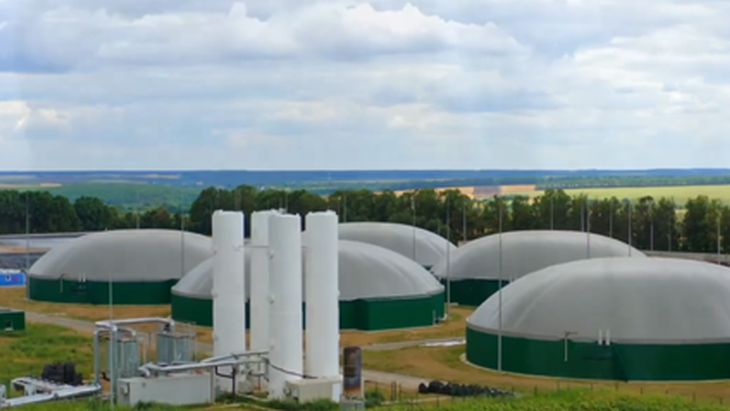As a renewable gas available in the European market, biomethane has the potential to replace a significant portion of natural gas supplies, contributing to a greener and more efficient energy landscape. It aligns with the goals set by the European Commission in the REPowerEU Plan, which aims to achieve an annual production target of 35 bcm of biomethane by 2030.
The 13-pages position paper released by Gas Infrastructure Europe presents three advantages of biomethane that are often overlooked and also the challenges that must be addressed in order to accelerate biomethane adoption.
Three advantages of biomethane against RES
Biomethane is the purified version of biogas, produced from the breakdown of organic matter. Biomethane can be made of organic waste, like manure, food scraps or damaged crops, and is therefore considered a modern way of waste management.
First, GIE notes that biomethane is more or less flat production and is storable, and thus always available, whereas RES electricity is intermittent, is much more difficult to store, and therefore not always directly available unless converted from molecules.
The transmission costs for biomethane are almost zero, as existing infrastructure can be used, whereas transmission costs for electricity are quite expensive. Also, flexibility costs for electricity are much higher compared to biomethane. The difference between the two approaches is sometimes referred to as Enhanced Levelised Cost of Energy (ELCOE) versus Levelised Cost of Energy (LCOE). The difference between both in renewable electricity is significant, whereas with biomethane, it is negligible.
Finally, biomethane production can create negative emissions, which we need to compensate for hard-to-abate sectors, renewable electricity cannot.
Barriers against biomethane development
The document identifies economic, technical, regulatory, and social barriers to biomethane development. It emphasises the importance of long-term regulatory frameworks, recognition of externalities, and the need for community engagement and education to overcome these challenges.
Economic Biomethane as a renewable energy source should be afforded the same support and recognition as other renewable energies, including in priority access, taxation, production and consumption supports. In other words, a level playing field should apply to biomethane.
Economic Long-term support schemes should be use to improve the security of supply, to give certainty to investors and, most importantly, to provide price stability for consumers, just like it was the case with renewable energy.
Economic Appropriate measurement of energy production and utilisation end-to-end is necessary to properly account for emissions management.
Economic Where support is offered to electric vehicles, corresponding schemes supporting renewable gas in transport, particularly in the heavy goods vehicles sector, should also be available.
Technical Application of generic standards of gas across the EU with respect to storage, odorisation etc should be deployed to facilitate greater cross-border trade.
Technical Consideration should be given to channel waste, either municipal, industry or agriculture towards anaerobic digestion facilities and how to best encourage this.
Technical The agriculture and food sectors in the EU need to be supported in amending their processes and practices to more effectively capture biowaste and operate within the circular economy, including support for biodiversity developments, waste management, digestate storage and handling, adoption of renewable fuel machinery and support for education programs in these sectors to adopt new practices.
Regulatory A stable long-term regulatory framework covering both biomethane production and consumption is required in order to provide certainty to both consumers and potential investors in biomethane production plants.
Regulatory The introduction of distinct timelines assigned to each stage of the permitting process would be beneficial.
Regulatory The design and permitting process should be coordinated locally while following an overall strategy at the national level.
Regulatory The concept of “right to inject” guarantees access to the gas network for the output of a biomethane plant, taking into account its economic feasibility of it and, thereby, enhancing the bankability of the project.
Regulatory Green Certificates (GOs) should be used in all EU member states by making sure that all issuing schemes are recognised in the same way. This will make it easier to trade GOs across borders and turn biomethane into money without having to count the same thing twice.
Social A lack of awareness in society at large and even within some industry sectors, (e.g. agriculture sector) of their potential contribution to biomethane production, both from a feedstock supply and renewable gas utilization perspective within their community make the adoption of this technology challenging in many EU member states
5 recommendations leading to success
- Establishing a level playing field across renewable energy sources.
- Creating an EU-wide certification scheme for cross-border trade in renewable gas.
- Developing a fair regulatory framework for renewable gas technologies and connections.
- Eliminating cross-border inhibitors by promoting quality and standards review.
- Raising awareness of the necessity and benefits of renewable gas.
DG Energy published recently a set of country fiches on biomethane aim to encourage and support further cooperation between EU countries and/or industry stakeholders, also in light of the ongoing process to update the National Energy and Climate Plans. Romania is described as having the ability to replace about 80% of current NG imports with biomethane. The biomethane potential in Romania is thought to be 2.0 bcm by 2030, with 1.9 bcm coming from anaerobic digestion and 0.1 bcm from gasification. Thus, Romania could be among the top biomethane markets in the EU27, with significant national benefits.
About GIE
Gas Infrastructure Europe (GIE) is the association representing the interests of European gas infrastructure operators active in gas transmission, gas storage and Liquefied Natural Gas (LNG) regasification. GIE currently represents 70 member companies from 26 countries. GIE’s vision is that by 2050, the gas infrastructure will be the backbone of the new innovative energy system, allowing European citizens to benefit from a secure, efficient and sustainable energy supply. GIE has established a specialised Working Group on Biomethane (WG) in 2022. Aiming to enhance further the cooperation among its members on this crucial topic, the association will establish a dedicated area in 2024.
